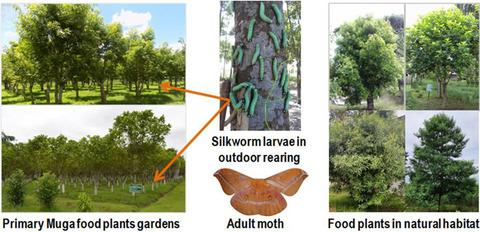当前位置:
X-MOL 学术
›
Entomol. Exp. Appl.
›
论文详情
Our official English website, www.x-mol.net, welcomes your
feedback! (Note: you will need to create a separate account there.)
Food plant diversity, distribution, and nutritional aspects of the endemic golden silk producing silkworm, Antheraea assamensis – a review
Entomologia Experimentalis et Applicata ( IF 1.4 ) Pub Date : 2021-01-28 , DOI: 10.1111/eea.13021 Barsha Devi 1 , Mahananda Chutia 2 , Nabanita Bhattacharyya 1
Entomologia Experimentalis et Applicata ( IF 1.4 ) Pub Date : 2021-01-28 , DOI: 10.1111/eea.13021 Barsha Devi 1 , Mahananda Chutia 2 , Nabanita Bhattacharyya 1
Affiliation

|
Muga silkworms, Antheraea assamensis (Helfer) (Lepidoptera: Saturniidae) is a semi‐domesticated sericigenous insect that produces the costliest golden colored exquisite silk. The silkworm is endemic to Assam and the adjoining areas of northeastern India. This multivoltine silkworm feeds on a variety of perennial food plants. However, less is known about the food plants of the silkworm other than the primary ones, namely Persea bombycina Kost. and Litsea monopetala (Roxb.) Pers. (both Lauraceae) in terms of rearing performances, diversity, nutritional aspects, and silkworm‐food plant relationships. Here, we review the utilization and present status of the food plants of Muga silkworm based on published information and field observations. Although 37 species belonging to eight families – namely Magnoliaceae, Lauraceae, Celastraceae, Verbenaceae, Apocynaceae, Symplocaceae, Rutaceae, and Rhamnaceae – were reported previously, only P. bombycina and L. monopetala have been exploited commercially and are being utilized in silkworm farming. Some other food plants documented previously are six Cinnamomum spp., five Litsea spp., three Symplocos spp., three Zanthoxylum spp., three Persea spp., three Actinodaphne spp., and two Celastrus spp. Systematic documentation, evaluation, and conservation of these food plants of Muga silkworm is urgently needed to preserve their gene pool in wild habitats. Silkworm farming in forest vicinity and tea silkworm‐based farming (as shade tree) may be experimentally tried which will aid the conservation of biodiversity with economic benefit.
中文翻译:

产金丝蚕worm蚕(Antheraea assamensis)的食用植物多样性,分布和营养方面的研究
穆加蚕(Antheraea assamensis(Helfer)(鳞翅目:Saturniidae))是一种半驯养的有源性昆虫,可生产成本最高的金色精美丝。蚕是阿萨姆邦和印度东北部毗邻地区的特有种。这种多电压家蚕以多种多年生食用植物为食。但是,除了主要的蚕(Persea bombycina Kost)以外,对蚕的食用植物知之甚少。和Litsea monopetala(Roxb。)个人 (都包括月桂科)在饲养性能,多样性,营养方面以及蚕食植物的关系方面。在此,我们根据公开的信息和现场观察来回顾穆加蚕食用植物的利用和现状。虽然37种,隶属于八大家族-即木兰科,樟科,卫矛科,马鞭草科,夹竹桃科,山矾科,芸香科和鼠李科-先前报道,仅P. bombycina和L. monopetala已经被商业利用和农蚕被利用。以前记录的其他一些食用植物是肉桂(Cinnamomum spp。),荔枝(Litsea)五种,Symplocos(symplocos)三种,花椒属,三个Persea属,三个Actinodaphne属和两个Celastrus属。迫切需要对穆加蚕的这些食用植物进行系统的文件记录,评估和保护,以在野生环境中保存其基因库。可以尝试在森林附近进行蚕农和以茶蚕为基础的种植(如树荫下),这将有助于保护生物多样性并带来经济利益。
更新日期:2021-02-15
中文翻译:

产金丝蚕worm蚕(Antheraea assamensis)的食用植物多样性,分布和营养方面的研究
穆加蚕(Antheraea assamensis(Helfer)(鳞翅目:Saturniidae))是一种半驯养的有源性昆虫,可生产成本最高的金色精美丝。蚕是阿萨姆邦和印度东北部毗邻地区的特有种。这种多电压家蚕以多种多年生食用植物为食。但是,除了主要的蚕(Persea bombycina Kost)以外,对蚕的食用植物知之甚少。和Litsea monopetala(Roxb。)个人 (都包括月桂科)在饲养性能,多样性,营养方面以及蚕食植物的关系方面。在此,我们根据公开的信息和现场观察来回顾穆加蚕食用植物的利用和现状。虽然37种,隶属于八大家族-即木兰科,樟科,卫矛科,马鞭草科,夹竹桃科,山矾科,芸香科和鼠李科-先前报道,仅P. bombycina和L. monopetala已经被商业利用和农蚕被利用。以前记录的其他一些食用植物是肉桂(Cinnamomum spp。),荔枝(Litsea)五种,Symplocos(symplocos)三种,花椒属,三个Persea属,三个Actinodaphne属和两个Celastrus属。迫切需要对穆加蚕的这些食用植物进行系统的文件记录,评估和保护,以在野生环境中保存其基因库。可以尝试在森林附近进行蚕农和以茶蚕为基础的种植(如树荫下),这将有助于保护生物多样性并带来经济利益。











































 京公网安备 11010802027423号
京公网安备 11010802027423号